同济大学:《结构动力学》课程教学资源(教案讲义)Lecture 08 Generalized SDOF Systems
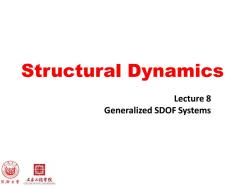
Structural Dynamics Lecture 8 Generalized SDOF Systems 闺 同桥大学 土本之程手院
Structural Dynamics Lecture 8 Generalized SDOF Systems

Contents General comments on generalized SDOF Generalized properties:assemblages of rigid bodies Generalized properties:distributed flexibility Vibration analysis by Rayleigh's method Selection of the Rayleigh's vibration shape 目 土本品程学院
Contents General comments on generalized SDOF Generalized properties: assemblages of rigid bodies Generalized properties: distributed flexibility Vibration analysis by Rayleigh’s method Selection of the Rayleigh’s vibration shape

Discrete system: All properties are modeled as discrete,such as dynamic response at spatial coordinates,both mass and stiffness,as well as damping ==>In matrix from =>ODE (Ordinary Differential Equations) Distributed system: Physical properties are modeled as distributed characteristics.Also called continuous system, distributed-parameter system =>Infinite number of DOF ==>PDE(Partial Differential Equations) 目 土亦工鞋季悦
Discrete system: All properties are modeled as discrete, such as dynamic response at spatial coordinates, both mass and stiffness, as well as damping ==>In matrix from ==> ODE (Ordinary Differential Equations) Distributed system: Physical properties are modeled as distributed characteristics. Also called continuous system, distributed-parameter system ==>Infinite number of DOF ==> PDE (Partial Differential Equations)
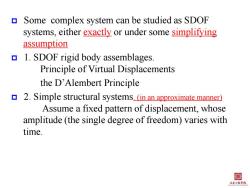
Some complex system can be studied as SDOF systems,either exactly or under some simplifying assumption 1.SDOF rigid body assemblages. Principle of Virtual Displacements the D'Alembert Principle 2.Simple structural systems.(in an approximate manner) Assume a fixed pattern of displacement,whose amplitude(the single degree of freedom)varies with time. 目 土本2程季院
Some complex system can be studied as SDOF systems, either exactly or under some simplifying assumption 1. SDOF rigid body assemblages. Principle of Virtual Displacements the D’Alembert Principle 2. Simple structural systems. (in an approximate manner) Assume a fixed pattern of displacement, whose amplitude (the single degree of freedom) varies with time

Generalized SDOF System can be treated as SDOF Many different,more complex systems can be studied as SDOF systems,either exactly or under some simplifying assumption. Case 1:Assemblage of rigid bodies The analysis provides exact results for an assemblage of rigid bodies supported such that it can deflect in only one shape Case 2:System with distributed mass and stiffness. Only approximate results for systems with distributed m and k Depends on the assumed deflected shape 闺 土本程李悦
Generalized SDOF • System can be treated as SDOF • Many different, more complex systems can be studied as SDOF systems, either exactly or under some simplifying assumption. Case 1: Assemblage of rigid bodies • The analysis provides exact results for an assemblage of rigid bodies supported such that it can deflect in only one shape Case 2: System with distributed mass and stiffness. • Only approximate results for systems with distributed m and k • Depends on the assumed deflected shape
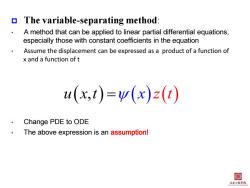
The variable-separating method: A method that can be applied to linear partial differential equations, especially those with constant coefficients in the equation Assume the displacement can be expressed as a product of a function of x and a function of t u(x,t)=v(x)z(t) Change PDE to ODE The above expression is an assumption! 目 土茅2粗季院
The variable-separating method: • A method that can be applied to linear partial differential equations, especially those with constant coefficients in the equation • Assume the displacement can be expressed as a product of a function of x and a function of t • Change PDE to ODE • The above expression is an assumption! u x t , xzt
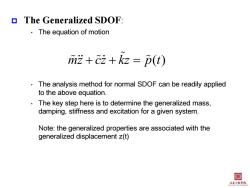
The Generalized SDOF: The equation of motion mz++kz p(t) The analysis method for normal SDOF can be readily applied to the above equation. The key step here is to determine the generalized mass, damping,stiffness and excitation for a given system. Note:the generalized properties are associated with the generalized displacement z(t) 闺 土本程李悦
The Generalized SDOF: • The equation of motion • The analysis method for normal SDOF can be readily applied to the above equation. • The key step here is to determine the generalized mass, damping, stiffness and excitation for a given system. Note: the generalized properties are associated with the generalized displacement z(t) mz cz kz p t ( )
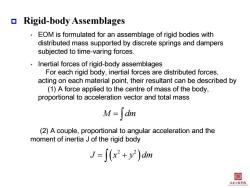
Rigid-body Assemblages EOM is formulated for an assemblage of rigid bodies with distributed mass supported by discrete springs and dampers subjected to time-varing forces. Inertial forces of rigid-body assemblages For each rigid body,inertial forces are distributed forces, acting on each material point,their resultant can be described by (1)A force applied to the centre of mass of the body, proportional to acceleration vector and total mass M=∫dm (2)A couple,proportional to angular acceleration and the moment of inertia J of the rigid body J=∫(x2+y2)dm 目 主京2相季院
Rigid-body Assemblages • EOM is formulated for an assemblage of rigid bodies with distributed mass supported by discrete springs and dampers subjected to time-varing forces. • Inertial forces of rigid-body assemblages For each rigid body, inertial forces are distributed forces, acting on each material point, their resultant can be described by (1) A force applied to the centre of mass of the body, proportional to acceleration vector and total mass (2) A couple, proportional to angular acceleration and the moment of inertia J of the rigid body M dm 2 2 J x y dm
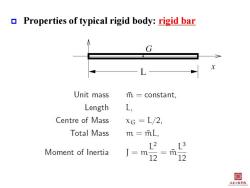
Properties of typical rigid body:rigid bar Unit mass m=constant, Length L, Centre of Mass xG L/2, Total Mass m mL, L2 L3 Moment of Inertia J=12 12 目 土本程李悦
Properties of typical rigid body: rigid bar

Properties of typical rigid body:rigid bar Unit mass m=constant, Length L, Centre of Mass xG L/2, Total Mass m =mL, L2 Moment of Inertia J=m12 =m 12 目 土水2程学院
Properties of typical rigid body: rigid bar
按次数下载不扣除下载券;
注册用户24小时内重复下载只扣除一次;
顺序:VIP每日次数-->可用次数-->下载券;
- 同济大学:《结构动力学》课程教学资源(教案讲义)Lecture 07 Frequency Domain Method.pdf
- 同济大学:《结构动力学》课程教学资源(教案讲义)Lecture 06 Numerical Evaluation of Dynamic Response.pdf
- 同济大学:《结构动力学》课程教学资源(教案讲义)Lecture 05 Response to Arbitrary, Step , and Pulse Excitations.pdf
- 同济大学:《结构动力学》课程教学资源(教案讲义)Lecture 04 Response to harmonic and periodic excitations - Application.pdf
- 同济大学:《结构动力学》课程教学资源(教案讲义)Lecture 03 Response to Harmonic and Periodic Excitations.pdf
- 同济大学:《结构动力学》课程教学资源(教案讲义)Lecture 02.pdf
- 同济大学:《结构动力学》课程教学资源(教案讲义)Lecture 01 Introduction of Structural Dynamics(负责人:陈隽).pdf
- 《力学》课程教学资源(试卷习题)美国物理试题与解答(第1卷)力学.pdf
- 长沙理工大学:《力学》课程教学资源(大纲教案)教学大纲 Mechanics.pdf
- 北京化工大学:《理论力学》课程教学资源(教案讲义)专题部分——机械振动基础.pdf
- 北京化工大学:《理论力学》课程教学资源(教案讲义)第十四章 虚位移原理 §14-1 约束、虚位移、虚功 §14-2 虚位移原理(虚功原理).pdf
- 北京化工大学:《理论力学》课程教学资源(教案讲义)第十三章 达朗贝尔原理.pdf
- 北京化工大学:《理论力学》课程教学资源(教案讲义)第十二章 动能定理 §12-6 普通定理的综合应用举例..pdf
- 北京化工大学:《理论力学》课程教学资源(教案讲义)第十二章 动能定理 §12-1 力的功 §12-2 质点和质点系的功能 §12-3 动能定理.pdf
- 北京化工大学:《理论力学》课程教学资源(教案讲义)第十一章 动量矩定理 §11-3 刚体绕定轴的转动微分方程 §11-5 质点系相对质心的动量矩定理 §11-6 刚体的平面运动微分方程.pdf
- 北京化工大学:《理论力学》课程教学资源(教案讲义)第十一章 动量矩定理 §11-1 质点和质点系的动量矩 §11-2 动量矩定理 §11-4 刚体对轴的转动惯量.pdf
- 北京化工大学:《理论力学》课程教学资源(教案讲义)第十章 动量定理 §10-3 质心运动定理.pdf
- 北京化工大学:《理论力学》课程教学资源(教案讲义)第九章 质点动力学的基本方程、第十章 动量定理 §10-1 动量与冲量 §10-2 动量定理.pdf
- 北京化工大学:《理论力学》课程教学资源(教案讲义)第八章 刚体的平面运动 §8-5 运动学综合应用举例.pdf
- 北京化工大学:《理论力学》课程教学资源(教案讲义)第八章 刚体的平面运动 §8-4 用基点法求平面图形内各点的加速度.pdf
- 同济大学:《结构力学》课程教学资源(教案讲稿,打印版)01 Introduction.pdf
- 同济大学:《结构力学》课程教学资源(教案讲稿,打印版)02 Kinematic(运动学)analysis of structures.pdf
- 同济大学:《结构力学》课程教学资源(教案讲稿,打印版)03 Reactions(反力).pdf
- 同济大学:《结构力学》课程教学资源(教案讲稿,打印版)04 Member Forces in Planar Trusses平面桥架()and Space Frameworks(空间构架).pdf
- 同济大学:《结构力学》课程教学资源(教案讲稿,打印版)05 Member Forces in Beams(梁)and Frames.pdf
- 同济大学:《结构力学》课程教学资源(教案讲稿,打印版)07 Elastic Deflections(弹性变形)of Trusses and Frameworks..pdf
- 同济大学:《结构力学》课程教学资源(教案讲稿,打印版)08 Elastic Deflections(弹性变形)of Beam and Frame Structures.pdf
- 同济大学:《结构力学》课程教学资源(教案讲稿,打印版)09 More Basic Concepts of Structural Analysis.pdf
- 同济大学:《结构力学》课程教学资源(教案讲稿,打印版)06 Influence Lines(影响线)and Maximum Load Effects..pdf
- 同济大学:《结构力学》课程教学资源(教案讲稿,打印版)10 Method of Consistent Deformations(协调变形法)(and Other Compatibility Methods).pdf
- 同济大学:《结构力学》课程教学资源(教案讲稿,打印版)11 Slope Deflection Method(转角变位移法)(and Other Equilibrium Methods).pdf
- 同济大学:《结构力学》课程教学资源(教案讲稿,打印版)12 Moment Distribution Method(弯矩分配法).pdf
- 同济大学:《结构力学》课程教学资源(教案讲稿,打印版)13 Matrix Displacement Method(矩阵位移法).pdf
- 同济大学:《结构力学》课程教学资源(教案讲稿,打印版)16 Dynamic analysis of structures.pdf
- 吉林大学:《土质学与土力学》课程教学资源(讲义,共十一章,负责人:郑孝玉).docx
- 科学出版社:现代力学丛书《高等断裂力学》书籍PDF电子版 Advanced Fracture Mechanics(2009版,共14章,主编:王自强、陈少华).pdf
- 国家自然科学基金重大项目:《材料的损伤断裂机理和宏微观力学理论》书籍PDF电子版(共六章,清华大学出版社,主编:黄克智、肖纪美).pdf
- 《断裂力学》课程教学资源(书籍教材)断裂力学教程电子版(PDF电子书,共四章).pdf
- 清华大学出版社:《损伤力学》书籍PDF电子版(PDF电子书,无图版,共七章,主编:余寿文).pdf
- 铁摩辛柯系列丛书(Timoshenko)简介 - MEMORIAL RESOLUTION STEPHEN P. TIMOSHENKO(187-1972).pdf
